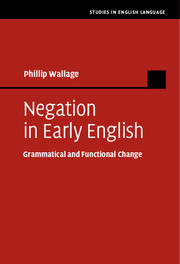Book contents
- Frontmatter
- Dedication
- Contents
- List of figures
- List of tables
- Acknowledgements
- Abbreviations
- 1 Introduction
- 2 Quantitative Evidence for a Model of the Jespersen Cycle in Middle English
- 3 Distributional Evidence for Two Types of ne: Redundant Negation
- 4 Distributional Evidence for Different Types of not
- 5 The Syntax of the Early English Jespersen Cycle: A Morphosyntactic Feature-based Account
- 6 The Role of Functional Change in the Jespersen Cycle
- 7 Negative Concord in Early English
- 8 Negative Inversion: Evidence for a Quantifier Cycle in Early English
- 9 The Loss of Negative Concord: Interaction Between the Quantifier Cycle and the Jespersen Cycle
- 10 Conclusion
- References
- Index of names
- Index of subjects
5 - The Syntax of the Early English Jespersen Cycle: A Morphosyntactic Feature-based Account
Published online by Cambridge University Press: 13 July 2017
- Frontmatter
- Dedication
- Contents
- List of figures
- List of tables
- Acknowledgements
- Abbreviations
- 1 Introduction
- 2 Quantitative Evidence for a Model of the Jespersen Cycle in Middle English
- 3 Distributional Evidence for Two Types of ne: Redundant Negation
- 4 Distributional Evidence for Different Types of not
- 5 The Syntax of the Early English Jespersen Cycle: A Morphosyntactic Feature-based Account
- 6 The Role of Functional Change in the Jespersen Cycle
- 7 Negative Concord in Early English
- 8 Negative Inversion: Evidence for a Quantifier Cycle in Early English
- 9 The Loss of Negative Concord: Interaction Between the Quantifier Cycle and the Jespersen Cycle
- 10 Conclusion
- References
- Index of names
- Index of subjects
Summary
It is clear from the preceding chapters that formal accounts of the Jespersen Cycle which assume a single form of ne such as Roberts and Roussou (2003), Zeijlstra (2004) do not accommodate the changes in the distribution of ne described in Chapters 2 and 3 and therefore fail to model the distribution of ne adequately across the Jespersen Cycle. Instead, we need a means to distinguish two forms of ne. One way to do this would be to invoke a semantic distinction between a negative marker with a semantic negative feature and a negative polarity item (NPI) without. However, it raises the issue of what properties the NPI ne has within a taxonomy of negative polarity items such as that proposed by Hoeksma (2012), and how it is licensed. Breitbarth (2009) proposes to treat ME ne as a non-veridical polarity item. Zeijlstra (2010) proposes that French ne is also a non-veridical NPI. However, this kind of analysis overgeneralises the distribution of ME ne. Instead, Middle English ne has the properties of an anti-veridical NPI, in that it must be licensed by negation. Furthermore, the licensing conditions on ME ne are subject to strict syntactic locality constraints.
Consequently, while it is plausible that an account could be sketched out in purely semantic terms to account for the changing distribution of ne, I instead model the changing distribution of ne within a Minimalist syntactic framework based on morphosyntactic features and feature agreement.
Syntactic Framework and Assumptions
The syntactic framework on which the analysis is based is a modified version of the Minimalist framework set out in Chomsky (1999, 2000), incorporating later proposals from Hiraiwa (2001), Pesetsky and Torrego (2007), Wurmbrand (2012) and Zeijlstra (2012). The approach is a modular one, in which the syntactic derivation assembles lexical items into larger structures which are interpreted or spelled out at two interfaces - PF (phonological form), where the morphological and phonological form of the syntactic unit is spelled out, and LF (logical form) where the syntactic unit is interpreted semantically. Semantic compositionality is fundamental, with the meaning of the structure read off its syntactic form.
- Type
- Chapter
- Information
- Negation in Early EnglishGrammatical and Functional Change, pp. 85 - 111Publisher: Cambridge University PressPrint publication year: 2017

